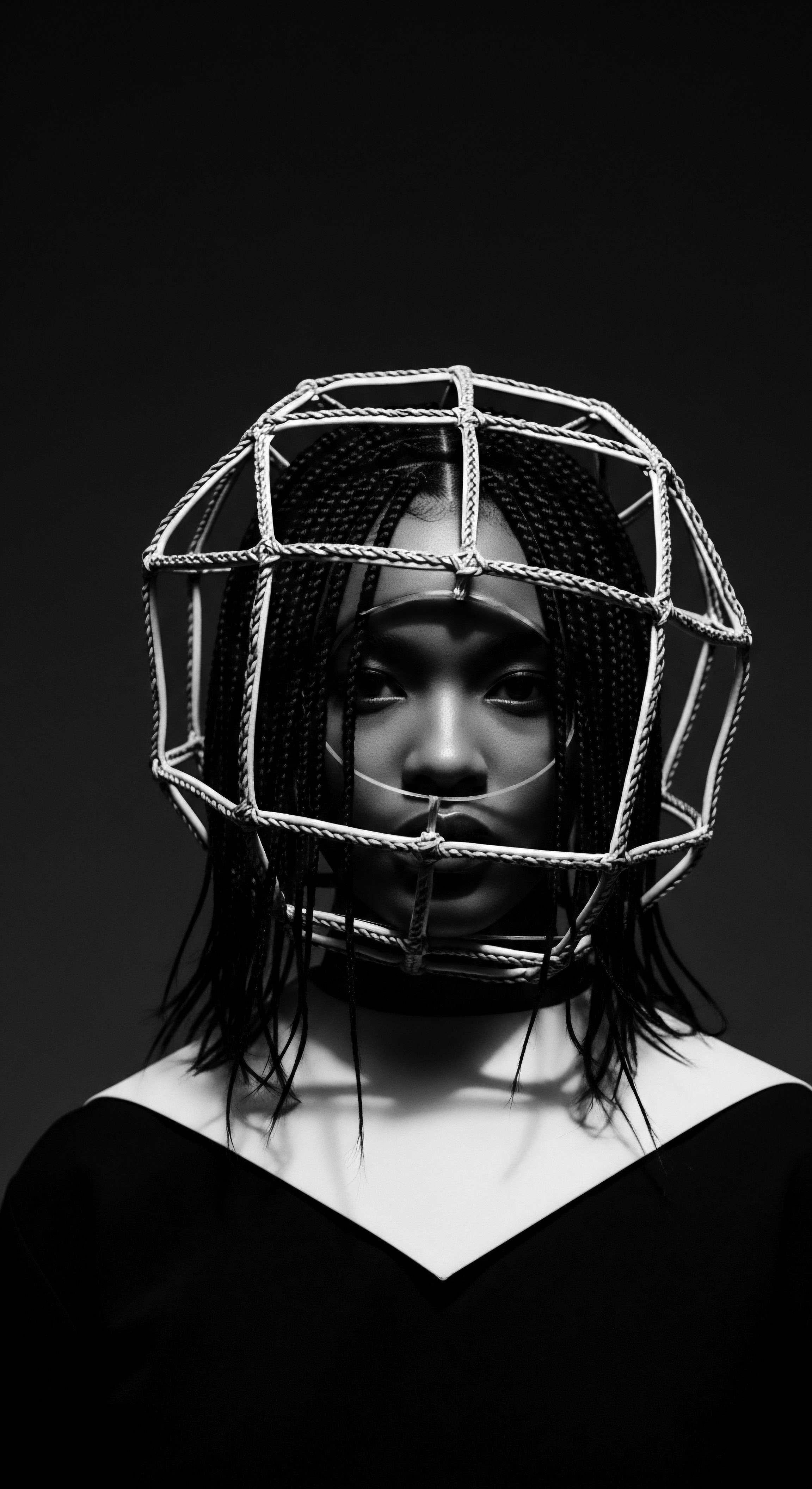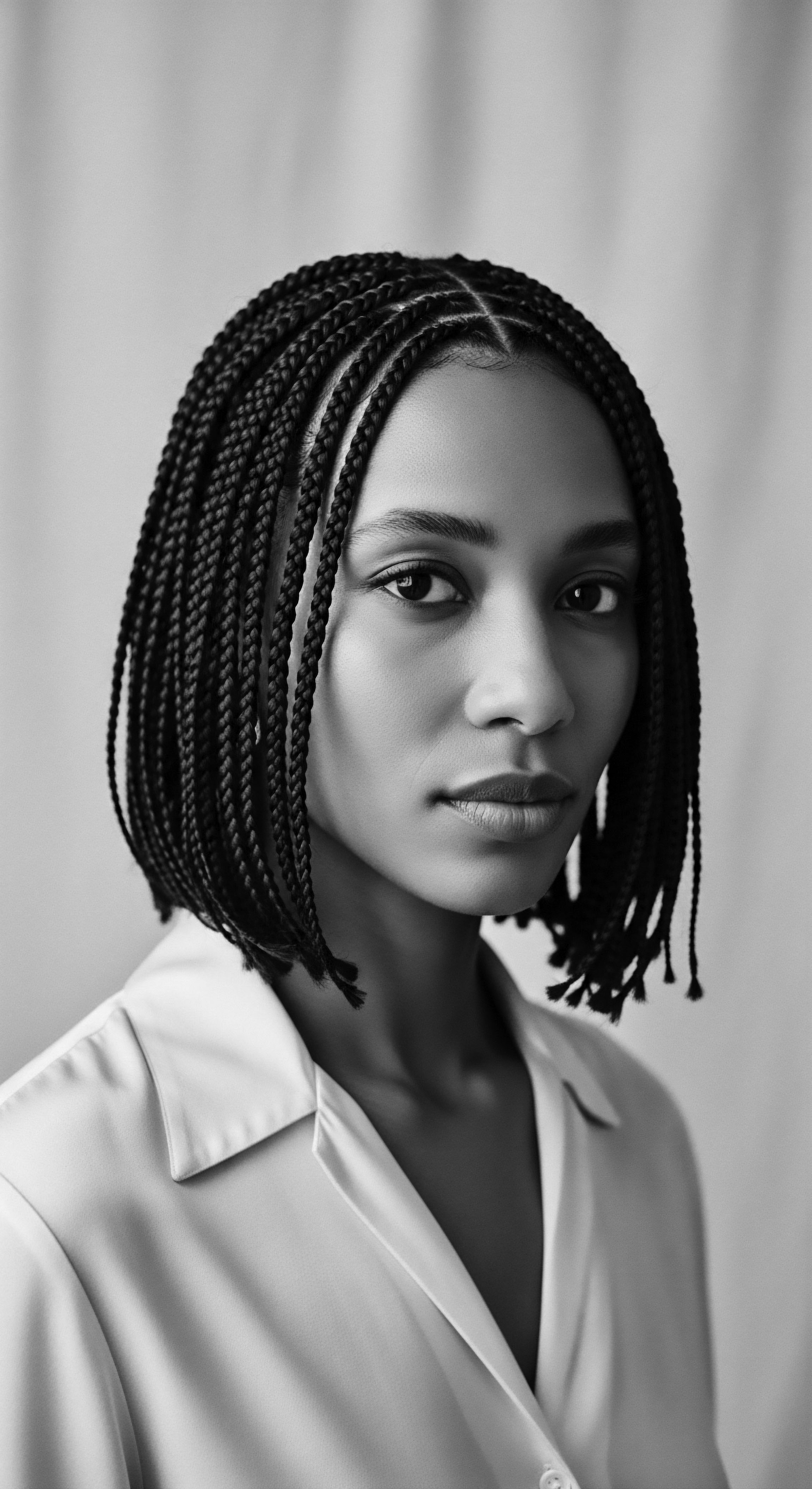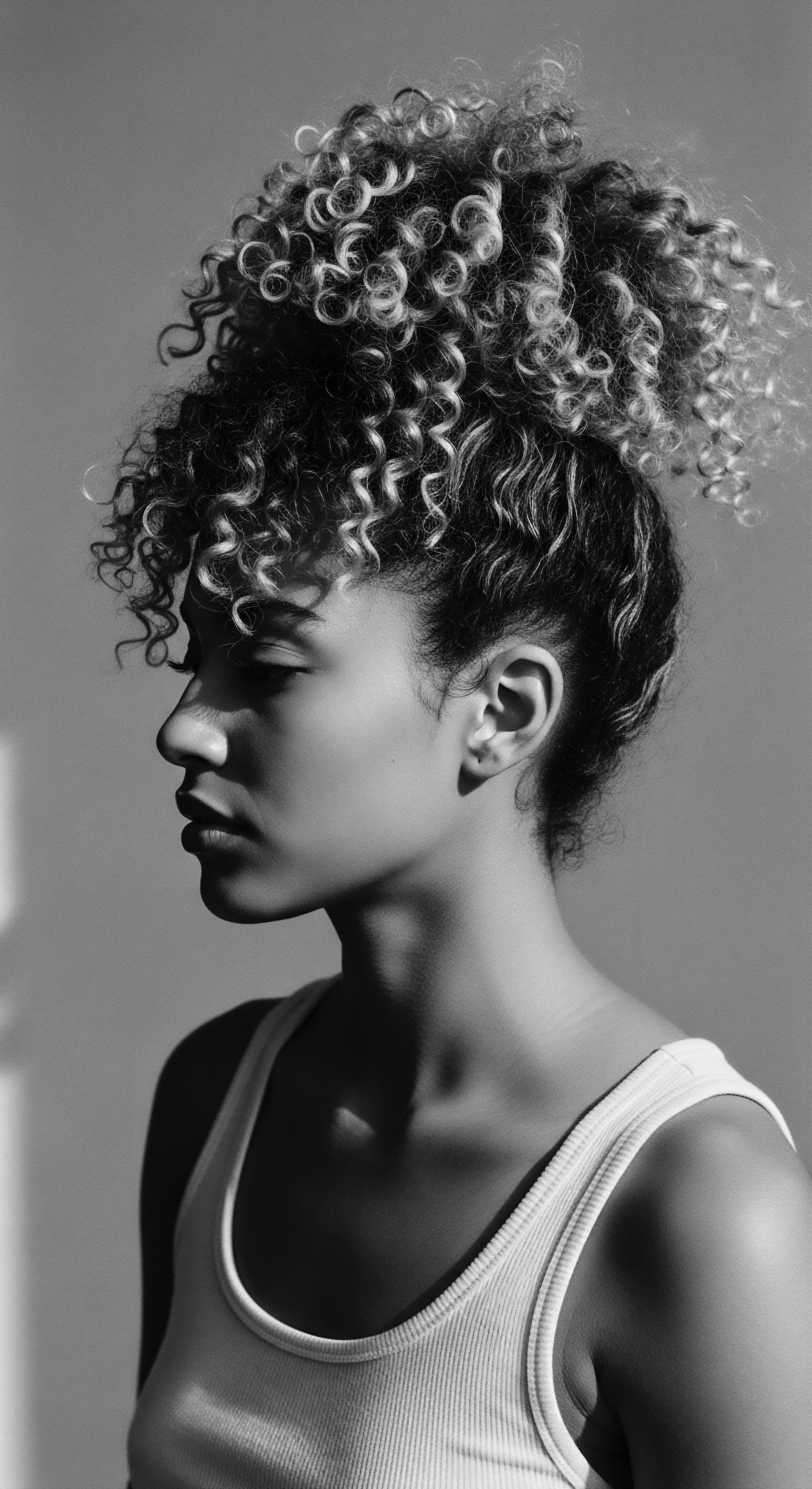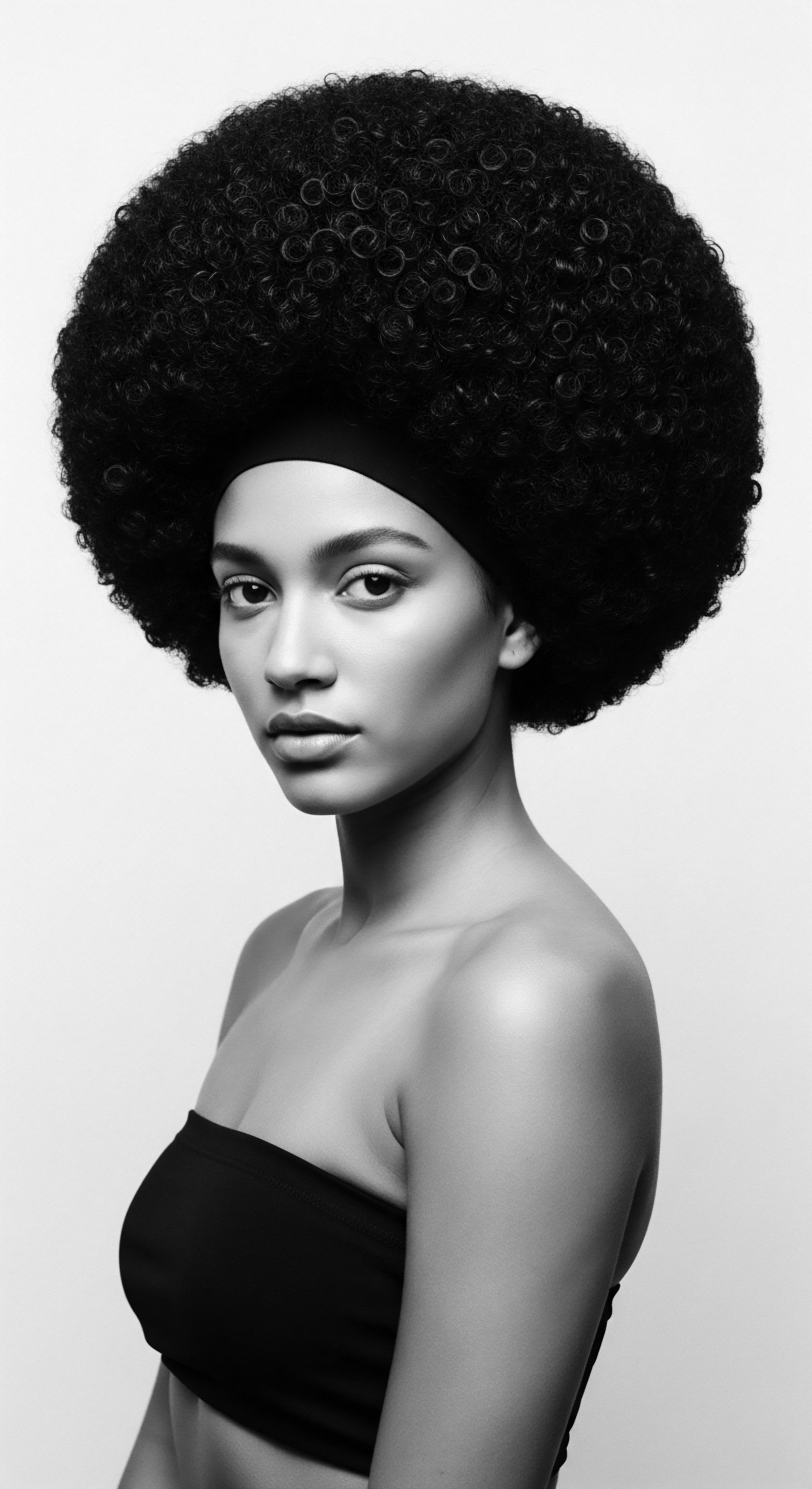
Roots
There exists within each curl, each coil, each gentle wave, a silent testament to ages past. A strand of textured hair holds more than mere biological structure; it carries the quiet echoes of ancestral hands, of ancient wisdom, and of traditions whispered through generations. This deep connection to heritage is not a relic confined to dusty archives; it pulses vibrantly in the routines we practice today. Can daily textured hair routines truly mirror these long-standing cultural traditions?
The query itself invites us into a profound inquiry, one that bids us look beyond the superficial act of grooming and recognize the living legacy held within every careful motion, every ingredient chosen, every style adopted. It is a dialogue between biology and lineage, science and spirit, then and now, all coursing through the unique landscape of Black and mixed-race hair. Here, where the very act of tending to one’s hair becomes a form of remembrance, a daily affirmation of belonging, the answer unfolds not in a simple yes or no, but in a rich, multi-layered story.

Ancestral Contours of Hair Biology
To truly comprehend the heritage woven into our routines, we must first recognize the elemental biology of textured hair itself. The intricate helical shape of individual hair strands, the unique distribution of melanin, the specific patterns of growth—these characteristics are not arbitrary. They are genetic signatures, honed over millennia within distinct ancestral lines. From the tightest coils to the softest waves, each pattern has deep historical roots, often linked to environmental adaptations or the markers of identity that coalesced within ancient communities.
Consider the sheer resilience of African hair, a resilience often demanded by the harsh desert sun or the humid forest air where many ancestral lines resided. The protective qualities of natural hair, its capacity for shrinkage, its density—these attributes were not flaws, but rather intrinsic defenses. They were understood, even if not articulated in modern scientific terms, by those who first learned to care for these hair types.
The understanding of hair anatomy, from the robust cuticle layers to the distinctive oval or flat shape of the hair follicle, finds an unexpected common ground with ancient practices. These practices, passed down through oral lore and demonstration, often instinctively provided what modern science now validates as beneficial. The very architecture of textured hair, with its unique challenges and strengths, meant that ancient care regimens, born of necessity and wisdom, were inherently responsive to its needs. This foundational knowledge, empirical and intuitive, became the first layer of our collective hair heritage.

What Does Hair Structure Tell Us About Our Past?
The very structure of textured hair offers a silent history book, each twist and turn a reflection of ancient genetic blueprints. This physical reality shaped, in turn, the earliest approaches to hair care. Unlike straight hair, coiled or kinky strands tend to be drier due to the structure of the cuticle, which can hinder the natural oils (sebum) from traversing the entire length of the hair shaft.
This inherent dryness, however, was not seen as a deficit in ancient times, but rather a characteristic that required specific, often elaborate, rituals for health and vitality. Such traditions, focusing on deep moisture and protection, developed organically over vast spans of time, becoming cornerstones of communal practice.
The physical characteristics of textured hair are themselves a biological record, influencing ancestral care methods long before scientific classification existed.
Ancient classifications of hair, often informal and based on visual or tactile qualities, informed social standing, tribal affiliation, and rites of passage. These distinctions were not about “types” as we label them today, but about the social meaning embedded in every style and texture. The language used to describe hair—whether through specific names for braids, symbolic colors, or adornments—spoke volumes about a person’s place within their community and their connection to a broader ancestral line.
One striking example of ancestral hair care reflecting direct environmental adaptation and cultural identity comes from the Himba people of Namibia. Their daily routines are steeped in profound heritage. The Himba women are renowned for their practice of coating their hair and skin with Otjize, a distinctive paste composed of red ochre, butterfat, and aromatic resin from the omuzumba shrub. This practice serves not only as a beauty ritual but also as a protective measure against the harsh desert sun and dry climate, simultaneously symbolizing blood, the essence of life, and the earth’s rich red color (INFRINGE, 2024; Alkebulan Mojo, 2025).
This daily application is a direct reflection of their environment and a deep connection to their land and lineage. Moreover, cleansing rituals among Himba women, involving traditional blends of water and nourishing herbs like marula or devil’s claw, are reported to improve hair condition for a significant 81% of Women in the tribe (Alkebulan Mojo, 2025), underscoring the efficacy of these ancestral methods.
| Aspect Hair Shape and Dryness |
| Ancient Understanding Recognized need for deep lubrication; hair absorbs water, requires re-application. |
| Modern Scientific View Microscopic examination reveals flatter, elliptical follicles leading to helical coiling, limiting sebum travel and increasing dryness. |
| Aspect Protective Qualities |
| Ancient Understanding Instinctive covering and compacting for survival and symbolism. |
| Modern Scientific View UV protection and physical cushioning due to density and coil patterns. |
| Aspect Growth Cycles |
| Ancient Understanding Observed periods of shedding and growth; influenced timing of rituals. |
| Modern Scientific View Phases (anagen, catagen, telogen) vary slightly by individual and hair type; genetics play a strong part. |
| Aspect The enduring wisdom of ancestral practices often aligns with current scientific discovery, demonstrating an intuitive grasp of hair's needs through generations of observation. |

Ritual
From the foundational biology of our hair, we move into the vibrant realm of ritual—the repeated, intentional acts that transform daily care into a profound connection to our heritage. Hair styling, far from being a superficial adornment, has served as a powerful language, communicating identity, status, and historical allegiance. Ancestral practices were not merely about appearance; they were expressions of belief, community, and the sacred. These meticulous traditions, honed over centuries, offer a rich lexicon for understanding how our contemporary daily routines echo a long lineage of artistry and purpose.

What Daily Styling Says About Our Past?
The very act of shaping textured hair into specific styles has, for countless generations, been imbued with deep cultural significance. These styles were often far more than aesthetic choices; they were markers of social standing, age, marital status, or even spiritual devotion. Consider the ancient African kingdoms where hair artistry was central to expressing societal hierarchies and tribal affiliations.
The complexity of a hairstyle could indicate wealth, the passage from girlhood to womanhood, or a woman’s availability for marriage. This semiotics of hair meant that daily styling was a conscious act of communication, a public declaration of one’s place within the community and ancestral line.
Protective styling, for instance, a cornerstone of many modern textured hair regimens, has a heritage reaching back into antiquity. These styles, which tuck away delicate ends and minimize manipulation, were developed out of practical necessity. They shielded hair from environmental harshness, reduced breakage, and allowed for sustained length. Braids, twists, and various forms of updos were not just fashionable; they were ingenious methods of safeguarding hair health in challenging conditions.
The Mbalantu women of Namibia offer a compelling lens into this tradition. They are known for their incredibly long, ankle-length Eembuvi Braids, which are maintained through elaborate, lifelong care routines. Girls begin their hair preparation around the age of twelve, applying a thick paste of ground Omutyuula Tree Bark mixed with fat, a practice that continues for years to foster growth and strength (Pulse, 2024; Gondwana Collection, 2012). This enduring practice highlights how daily application and intricate styling rituals serve as powerful conduits for cultural legacy.

How Do Ancient Tools Speak to Our Present Care?
The tools and techniques employed in ancient hair styling also possess a profound story. Though perhaps simpler in form than their modern counterparts, these implements were crafted with purpose, often from natural materials like wood, bone, or horn. Combs carved with specific symbols, adornments of beads, shells, or precious metals—these were not just functional items.
They were extensions of cultural identity, used in communal grooming rituals that served as vital social bonding experiences. The shared time spent styling hair, often among women of various generations, created intimate spaces for storytelling, for the transmission of ancestral knowledge, and for reinforcing familial and communal ties.
The ingenuity of ancient stylists shines through in their ability to manipulate textured hair into gravity-defying sculptures and intricate patterns without the aid of modern heat or chemical treatments. These techniques relied on a deep understanding of hair’s natural properties, its capacity for memory, and its response to moisture and manipulation. This intimate knowledge of hair’s behavior, gleaned through countless hours of practice and observation, forms the bedrock of traditional styling methods. Even in our contemporary world, where innovative tools and products abound, the foundational principles of gentle handling, sectioning, and precise application echo these ancient traditions.
Here are some examples of ancient hair care practices and their lasting legacy:
- Braiding ❉ Originating in Africa as early as 3500 BCE, braids were used to signify tribal affiliation, social status, and marital status, and served as protective styles for longevity (Shedavi, 2023; OkayAfrica, 2023).
- Hair Oiling/Pastes ❉ The Himba’s use of otjize and the Mbalantu’s omutyuula bark paste exemplify the ancient tradition of sealing in moisture and protecting hair from environmental stressors with natural ingredients (INFRINGE, 2024; Pulse, 2024).
- Communal Grooming ❉ The shared activity of hair styling fostered social bonds and the transmission of knowledge across generations (Shedavi, 2023).

Relay
The relay of heritage is a continuous current, carrying ancestral wisdom from the past into our contemporary lives. Our daily textured hair regimens, therefore, are not merely personal acts of grooming; they represent a vibrant continuation of care practices rooted in ancient traditions. This transmission of knowledge, often informal and intergenerational, shows how modern routines can indeed reflect the intricate, often holistic, approaches to hair health that characterized life in earlier eras.

Can Modern Wellness Align with Ancient Hair Philosophies?
The drive towards holistic well-being, now prevalent in many health and beauty spaces, finds a compelling alignment with ancestral hair philosophies. For numerous Black and mixed-race communities throughout history, hair was rarely viewed in isolation from the body or spirit. It was, rather, considered an extension of self, a conduit for spiritual connection, and a physical manifestation of communal identity.
This perspective contrasts sharply with a purely cosmetic approach to hair care, instead positioning it within a broader framework of spiritual, emotional, and physical health. The Yoruba people, for instance, would braid their hair to communicate with their gods and goddesses, viewing hair care as essential for both external appearance and inner spirituality (Shedavi, 2023).
Nighttime rituals, a cornerstone of optimal textured hair care today, also find their mirror in ancient practices. Head coverings, whether for protection, adornment, or spiritual observance, have existed across various African cultures for centuries. These coverings shielded hair from dust, prevented tangling during sleep, and often preserved intricate daytime styles.
The modern bonnet, a ubiquitous tool for many with textured hair, serves a similar function, safeguarding the strands from friction and moisture loss against absorbent fabrics. This seemingly simple accessory is a direct descendent of ancestral ingenuity, a testament to the enduring understanding that protection during rest is paramount for hair health.

What Ancient Ingredients Still Hold Power in Our Routines?
A careful survey of traditional ingredients reveals a deep understanding of botany and natural chemistry that predates modern scientific classification. Ancestral communities relied heavily on locally sourced herbs, oils, butters, and clays, each chosen for specific therapeutic or protective properties. Marula oil, shea butter, palm oil, and various plant extracts were not merely applied; their application was part of a structured ritual, often involving fermentation, heating, or specific combinations to maximize their efficacy.
The Himba women’s use of otjize , with its blend of butterfat, ochre, and aromatic resin, is not just about color; it serves as a natural moisturizer and sunblock, significantly reducing dryness and breakage by approximately 60% with regular use (Alkebulan Mojo, 2025). This deeply practical yet symbolic application showcases the sophisticated knowledge of natural resources.
The continued prominence of certain natural elements in contemporary hair care speaks to a timeless efficacy recognized across historical epochs.
Today, as we seek out natural, clean ingredients, we are, in a sense, returning to the wisdom of our forebears. The scientific validation of ingredients like argan oil for its fatty acid content, or plant-based proteins for strengthening, often echoes the intuitive benefits discovered by ancient practitioners. The convergence of ancient knowledge and modern research allows for a more profound appreciation of the traditional remedies and ingredients that have sustained textured hair for millennia. This continuity provides a powerful framework for addressing common hair concerns, drawing from a wellspring of ancestral solutions.
| Traditional Ingredient/Practice Red Ochre & Butter (e.g. Himba Otjize) |
| Ancestral Purpose Sun protection, moisture seal, symbolic adornment. |
| Modern Parallel/Scientific Validation Mineral sunscreens, emollients, fatty acids for moisture retention. |
| Traditional Ingredient/Practice Omutyuula Bark Paste (Mbalantu) |
| Ancestral Purpose Hair growth stimulation, conditioning, protective coating. |
| Modern Parallel/Scientific Validation Botanical extracts for scalp health, protein treatments. |
| Traditional Ingredient/Practice Plant-based Oils/Fats |
| Ancestral Purpose Lubrication, shine, strength, treatment for scalp conditions. |
| Modern Parallel/Scientific Validation Carrier oils (jojoba, coconut), essential oils, emollients for cuticle health. |
| Traditional Ingredient/Practice Herbal Cleansers |
| Ancestral Purpose Gentle cleansing, scalp purification, therapeutic properties. |
| Modern Parallel/Scientific Validation Sulfate-free shampoos, herbal rinses, scalp treatments. |
| Traditional Ingredient/Practice Many contemporary hair solutions are, at their heart, refined iterations of ancient botanical wisdom and practical protection. |
The cyclical nature of daily care, with its emphasis on cleansing, moisturizing, sealing, and protecting, mirrors the cyclical worldview common in many traditional societies. These practices were not one-off events but ongoing, consistent commitments to hair health and beauty, deeply embedded in the rhythms of daily life. This continuous care is the enduring thread connecting our modern routines to the ancient hands that first sculpted, braided, and nurtured textured hair.

Reflection
To ask “Can Daily Textured Hair Routines Reflect Ancient Cultural Traditions?” is to embark on a journey that transcends the mere act of grooming, leading instead to a profound connection with the echoes of our past. We discover that the very texture of our hair, the intuitive movements of our hands during care, and the ingredients we seek out, all carry the resonance of ancestral practices. It is a living legacy, not merely a historical footnote. Each curl carefully tended, each braid intricately fashioned, each protective step taken, becomes a whispered conversation with the generations that came before.
In this space, where science meets spirit and modern meets ancestral, the soul of a strand truly comes alive. Our daily routines are not just reflections; they are active participations in an ongoing heritage, ensuring that the wisdom of the past continues to shape the narratives of our textured crowns.

References
- Alkebulan Mojo. (2025, February 20). The Enigmatic Hair Rituals of the Himba Tribe ❉ Unlocking the Secrets to Long, Luscious Locks.
- Gondwana Collection. (2012, June 20). Mbalantu – The eembuvi-plaits of the Women.
- INFRINGE. (2024). Himba Hair Rituals.
- OkayAfrica. (2023, May 11). A Regional Walk Through The History of African Hair Braiding.
- Pulse. (2024, March 20). Meet the tribe with the longest hair in Africa ❉ The secrets of their ankle-length hair.
- Shedavi. (2023, February 3). History of Black Hair & Its Hidden Symbolism.
